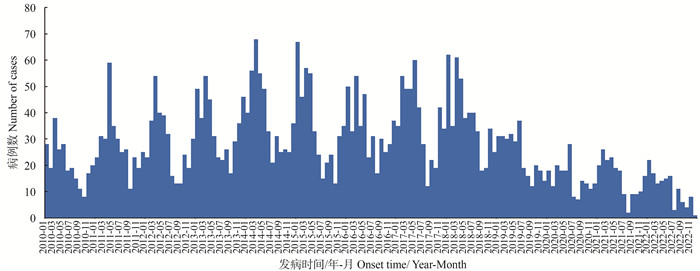Epidemic characteristics and spatiotemporal clustering of hemorrhagic fever with renal syndrome in Guangdong Province, 2010-2022
-
摘要:
目的 回顾性分析2010—2022年广东省肾综合征出血热(hemorrhagic fever with renal syndrome, HFRS)流行特征和时空聚集性,为探索HFRS高危地区和制定防控措施提供参考。 方法 HFRS数据来源于中国疾病预防控制信息系统,运用Joinpoint 4.6.0.0软件对HFRS报告病例数据进行趋势分析,运用GeoDa 1.16软件开展全局和局部空间自相关分析,使用SaTScan 10.1软件进行时空扫描,通过计算对数似然比(log-likelihood ratio, LLR)分析HFRS时空聚集性。 结果 2010—2022年广东省累计报告HFRS病例4 322例,年均发病率为0.31/10万,利用平均年度变化百分比(average annual percent change,AAPC)来评价整体趋势性变化,发病率整体呈下降趋势(AAPC=-8.4%, 95% CI:-12.6%~-3.9%)。3—4月为HFRS高发月份(RR=1.61, LLR=82.78, P=0.001)。珠三角地区、男性、30~69岁人群发病率最高。职业以家务及待业(973例,占22.51%)、商业服务(726例,占16.80%)、工人(645例,占14.92%)和农民(638例,占14.76%)居多。HFRS发病存在空间聚集性,“高-高”聚集区主要分布在珠三角地区的广州市和佛山市。时空扫描分析结果显示,1个一类聚集区位于广州市、佛山市的9个县(区),发生在2013年2—3月;2个二类聚集区主要涉及珠三角地区的7个地级市和粤西地区的阳江市的25个县(区),发生在2015年1—2月和2017年5—6月。每年的聚集区均出现在珠三角地区,不同年份涉及的地级市和县(区)有所不同,主要集中在广州市、佛山市,主要发生在冬春季,少数年份在夏季初。 结论 2010—2022年广东省HFRS发病率呈下降趋势,发病存在季节性和空间聚集性,冬春季为高发季节,珠三角地区为高发区域,中老年为主要高发人群。 Abstract:Objective To conduct a retrospective analysis of the monitoring data on hemorrhagic fever with renal syndrome (HFRS) in Guangdong Province from 2010 to 2022, and explore characteristics and spatiotemporal clustering of HFRS data, so as to identify high-risk areas for HFRS and provide references for the development of targeted prevention and control measures. Methods The data on HFRS were obtained from the Chinese National Disease Reporting Information System. We conducted a trend analysis of HFRS case data using Joinpoint 4.6.0.0 and assessed spatial autocorrelation with GeoDa 1.16. Spatio-temporal clusters were identified using SaTScan 10.1, where the log-likelihood ratio (LLR) indicated the strength of clusters. Results From 2010 to 2022, Guangdong reported 4 322 HFRS cases, with an average annual incidence rate of 0.31 per 100 000. The incidence rate exhibited a decreasing trend (AAPC=-8.4%, 95% CI: -12.6%--3.9%). Peak cases occurred in March and April (RR=1.61, LLR=82.78, P=0.001). Males and those aged 30-69 were disproportionately affected. The Pearl River Delta, especially Guangzhou and Foshan, reported the highest incidence. Occupationally, those engaged in household chores and unemployed individuals (n=973, 22.51%), commercial service personnel (n=726, 16.80%), workers (n=645, 14.92%), and farmers (n=638, 14.76%) were relatively numerous. Spatial clustering was evident, with clusters centered in the Pearl River Delta. Spatio-temporal analysis identified clusters in Guangzhou, Foshan, and other regions of Guangdong. HFRS occurred primarily in winter and spring, with occasional summer outbreaks, consistently affecting the Pearl River Delta, particularly Guangzhou and Foshan. The spatial clustering of HFRS cases is prominent, with "high-high" clusters concentrated in Guangzhou and Foshan within the Pearl River Delta. Through spatiotemporal scanning analysis, we identified one type Ⅰ cluster encompassing nine counties in Guangzhou and Foshan from February to March 2013. Additionally, two type Ⅱ clusters were detected, occurring in January to February 2015 and May to June 2017, respectively. One affected seven cities in the Pearl River Delta, while the other encompassed 25 counties in Yangjiang City in West Guangdong. Annual scans showed that while HFRS primarily occurs in winter and spring, there are occasional early summer outbreaks. The affected cities and counties vary annually, but the Pearl River Delta, especially Guangzhou and Foshan, remains a consistent focal point. Conclusions The incidence of HFRS in Guangdong shows a downward trend. HFRS occurs frequently in winter and spring. The middle-aged and the elderly are the main groups with high incidence. The disease exhibits seasonal and spatial clustering characteristics, with the Pearl River Delta region being the high-incidence area. -
图 2 2010—2022年广东省HFRS局部空间自相关分析LISA聚集图
HFRS: 肾综合征出血热; “高-高”聚集表示这些区域为HFRS高发区域的聚集区,需对该区域重点关注;“低-低”聚集表示这些区域为HFRS低发区域的聚集区,应进一步提高监测敏感性。
Figure 2. Local indicators of spatial association (LISA) aggregation map of HFRS local spatial autocorrelation analysis in Guangdong Province, 2010-2022
HFRS: hemorrhagic fever with renal syndrome; "High-high" clustering areas refer to regions with high HFRS incidence surrounded by similar areas; These areas require close attention; "Low-low" clustering areas with low HFRS incidence need enhanced monitoring sensitivity for precise evaluation.
表 1 广东省2010—2022年HFRS发病情况及其变化趋势
Table 1. The incidence and trend of HFRS in Guangdong Province, 2010-2022
变量Variable 累计报告病例数
Cumulative reported cases平均年发病率
/10万-1
Average annual incidence rate/100 000-1整体趋势Overall trend 分区段趋势Segmented trend AAPC值value(95% CI)/% P值value 起止年度Start and end year APC值value(95% CI)/% P值value 广东省Guangdong Province 4 322 0.306 -8.4(-12.6~-3.9) <0.001 2010—2014 11.8(2.5~22.1) 0.022 2014—2018 -2.6(-13.5~9.8) 0.600 2018—2022 -29.4(-36.9~-20.9) 0.001 地区Area 珠三角地区Pearl River Delta 3 685 0.480 -10.0(-12.8~-7.2) <0.001 2010—2014 9.2(3.2~15.6) <0.001 2014—2018 -3.2(-10.6~4.8) 0.300 2018—2022 -31.2(-36.2~-25.8) <0.001 粤东East Guangdong 289 0.129 6.2(-4.1~17.5) 0.200 2010—2014 75.7(29.3~138.7) <0.001 2014—2022 -17.5(-24.7~-9.5) <0.001 粤西West Guangdong 194 0.095 -3.0(-11.0~5.7) 0.400 2010—2022 -3.0(-11.0~5.7) 0.400 山区Mountain region 154 0.072 -1.0(-9.1~7.8) 0.800 2010—2022 -1.0(-9.1~7.8) 0.800 性别Gender 男性Male 3 243 0.483 -7.7(-11.5~-3.8) <0.001 2010—2017 6.7(1.7~12.0) <0.001 2017—2022 -24.7(-31.6~-17.2) <0.001 女性Female 1 079 0.146 -9.1(-16.8~-0.6) <0.001 2010—2013 21.4(-7.9~60.0) 0.100 2013—2018 -3.4(-16.2~11.4) 0.600 2018—2022 -32.2(-45.5~-15.6) <0.001 年龄组/岁Age group/years 0~<10 4 0.002 -3.4(-5.2~-1.5) <0.001 2010—2022 -3.4(-5.2~-1.5) <0.001 10~<20 122 0.058 -5.0(-15.0~6.2) 0.300 2010—2022 -5.0(-15.0~6.2) 0.300 20~<30 837 0.300 -10.1(-16.0~-3.7) <0.001 2010—2018 -2.0(-6.7~2.8) 0.400 2018—2022 -24.2(-39.3~-5.4) <0.001 30~<40 995 0.452 -12.9(-16.9~-8.7) <0.001 2010—2018 -1.4(-5.1~2.4) 0.400 2018—2022 -32.0(-41.3~-21.2) <0.001 40~<50 1 089 0.512 -9.7(-13.7~-5.4) <0.001 2010—2017 3.8(-1.4~9.3) 0.100 2017—2022 -25.6(-33.3~-17.1) <0.001 50~<60 747 0.502 -1.9(-10.8~8.0) 0.700 2010—2013 58.2(14.4~118.9) <0.001 2013—2018 0.6(-14.2~17.9) 0.900 2018—2022 -33.5(-45.8~-18.3) <0.001 60~<70 377 0.459 -8.1(-17.9~3.0) 0.100 2010—2013 38.5(-6.3~104.6) 0.100 2013—2018 0.3(-15.3~18.8) 1.000 2018—2022 -39.4(-53.4~-21.2) <0.001 70~<80 113 0.220 -3.5(-14.7~9.3) 0.500 2010—2022 -3.5(-14.7~9.3) 0.500 ≥80 38 0.170 -7.9(-15.2~0.1) 0.100 2010—2022 -7.9(-15.2~0.1) 0.100 注:HFRS, 肾综合征出血热;AAPC,年均百分比变化;APC,年度百分比变化。
Note: HFRS, hemorrhagic fever with renal syndrome; AAPC, average annual percent change; APC, annual percent changes.表 2 广东省2010—2022年HFRS全局空间自相关分析结果
Table 2. Spatial autocorrelation analysis results of HFRS in Guangdong Province, 2010-2022
年份
YearMoran′s I s Z值
valueP值
value2010 0.296 2 0.056 6 5.368 1 0.001 2011 0.371 1 0.061 0 6.235 4 0.001 2012 0.582 6 0.060 0 9.815 0 0.001 2013 0.441 0 0.056 1 8.033 2 0.001 2014 0.489 1 0.058 6 8.483 1 0.001 2015 0.390 6 0.058 1 6.858 4 0.001 2016 0.411 7 0.059 6 7.047 1 0.001 2017 0.402 4 0.062 7 6.512 3 0.001 2018 0.353 7 0.061 2 5.868 5 0.001 2019 0.408 0 0.058 7 7.068 5 0.001 2020 0.191 1 0.061 5 3.179 5 0.002 2021 0.274 4 0.060 6 4.627 7 0.001 2022 0.171 2 0.059 3 3.046 5 0.011 注:HFRS, 肾综合征出血热。
Note: HFRS, hemorrhagic fever with renal syndrome.表 3 广东省2010—2022年HFRS时空扫描分析结果
Table 3. HFRS spatiotemporal scanning analysis results in Guangdong Province, 2010-2022
扫描年度
Scanning year聚集区域
Cluster area涉及县(区)数
Number of affected districts发生时间/(年-月)
Occurrence time/(year-month)扫描半径/km
Scanning radius /km实际病例数
Actual number of cases期望病例数
Theoretical number of casesLLR值
valueRR值
valueP值
value2010—2022 一类聚集区Primary cluster 9 2013/02—2013/03 38.26 58 6.20 78.17 9.46 <0.001 二类聚集区A Secondary cluster A 6 2015/01—2015/02 42.35 37 6.99 31.73 5.33 <0.001 二类聚集区B Secondary cluster B 19 2017/05—2017/06 88.68 26 7.73 13.30 3.38 0.020 2010 一类聚集区Primary cluster 14 2010/03—2010/04 53.05 37 6.82 34.35 6.20 <0.001 2011 一类聚集区Primary cluster 12 2011/04—2011/05 45.45 46 8.54 42.25 6.09 <0.001 2012 一类聚集区Primary cluster 16 2012/03—2012/04 52.96 64 11.17 63.36 6.82 <0.001 2013 一类聚集区Primary cluster 9 2013/02—2013/03 38.26 58 8.10 67.45 8.16 <0.001 2014 一类聚集区Primary cluster 11 2014/02—2014/03 49.91 60 14.39 42.46 4.64 <0.001 二类聚集区Secondary cluster 4 2014/04—2014/05 42.26 15 3.48 10.53 4.42 0.028 2015 一类聚集区Primary cluster 11 2015/01—2015/02 49.91 61 13.03 49.14 5.31 <0.001 2016 一类聚集区Primary cluster 10 2016/01—2016/02 41.24 47 9.92 40.62 5.63 <0.001 二类聚集区Secondary cluster 1 2016/03—2016/04 0 26 5.20 21.58 5.27 <0.001 2017 一类聚集区Primary cluster 18 2017/04—2017/05 63.87 60 14.68 41.63 4.57 <0.001 2018 一类聚集区Primary cluster 13 2018/01—2018/02 46.02 54 12.56 39.30 4.74 <0.001 2019 一类聚集区Primary cluster 19 2019/05—2019/06 59.00 39 9.55 27.03 4.56 <0.001 2020 一类聚集区Primary cluster 10 2020/05—2020/06 54.46 22 5.48 14.87 4.44 <0.001 2021 一类聚集区Primary cluster 7 2021/03—2021/04 29.53 18 3.45 15.77 5.67 <0.001 二类聚集区Secondary cluster 3 2021/01—2021/02 10.48 9 1.05 11.53 8.92 0.008 2022 一类聚集区Primary cluster 1 2022/04—2022/05 0 8 0.31 18.51 27.03 <0.001 二类聚集区Secondary cluster 3 2022/06—2022/06 39.40 6 0.21 14.59 30.58 <0.001 注:HFRS, 肾综合征出血热。
Note: HFRS, hemorrhagic fever with renal syndrome. -
[1] 刘杰, 邓爱萍, 彭志强. 广东省2009—2013年肾综合征出血热流行特征分析[J]. 医学动物防制, 2017, 33(6): 606-609. DOI: 10.7629/yxdwfz201706005.Liu J, Deng AP, Peng ZQ. Analysis of epidemiologic characteristics of hemorrhagic fever patients with renal syndrome (HFRS) in Guangdong from 2009 to 2013[J]. J Med Pest Contrl, 2017, 33(6): 606-609. DOI: 10.7629/yxdwfz201706005. [2] 张亚萍, 王文英, 李莉莉, 等. 我国肾综合征出血热流行病学特征及预防控制研究现状[J]. 中华卫生杀虫药械, 2020, 26(4): 387-393. DOI: 10.19821/j.1671-2781.2020.04.026.Zhang YP, Wang WY, Li LL, et al. Research status of epidemiology and prevention and control of hemorrhagic fever with renal syndrome in China[J]. Chinese Journal of Hygienic Insecticides and Equipments, 2020, 26(4): 387-393. DOI: 10.19821/j.1671-2781.2020.04.026. [3] 刘天, 童叶青, 刘漫, 等. 2004—2017年全国肾综合征出血热变化趋势分析[J]. 中国人兽共患病学报, 2022, 38(6): 515-522, 547. https://www.cnki.com.cn/Article/CJFDTOTAL-ZRSZ202206010.htmLiu T, Tong YQ, Liu M, et al. Analysis of the trend of hemorrhagic fever with renal syndrome in China from 2004 to 2017[J]. Chinese Journal of Zoonoses, 2022, 38(6): 515-522, 547. https://www.cnki.com.cn/Article/CJFDTOTAL-ZRSZ202206010.htm [4] He JY, He JM, Han ZH, et al. Environmental determinants of hemorrhagic fever with renal syndrome in high-risk counties in China: a time series analysis (2002-2012)[J]. Am J Trop Med Hyg, 2018, 99(5): 1262-1268. DOI: 10.4269/ajtmh.18-0544. [5] 郝瑞峰, 梅启庆, 黄满涛, 等. 广东省流行性出血热疫源地首次调查报告[J]. 广州医药, 1984, 15(2): 7-10. https://www.cnki.com.cn/Article/CJFDTOTAL-GZYY198402002.htmHao RF, Mei QQ, Huang MT, et al. The first investigation report of epidemic hemorrhagic fever foci in Guangdong Province[J]. Guangzhou Medical Journal, 1984, 15(2): 7-10. https://www.cnki.com.cn/Article/CJFDTOTAL-GZYY198402002.htm [6] 余靓, 梁丽君, 黄平, 等. 广东地区肾综合征出血热流行特征与气象因素的ARIMA模型分析[J]. 中华疾病控制杂志, 2016, 20(8): 851-855. DOI: 10.16462/j.cnki.zhjbkz.2016.08.024.Yu L, Liang LJ, Huang P, et al. An ARIMA model of epidemiological features of hemorrhagic fever with renal syndrome and its meteorological factors in Guangdong[J]. Chin J Dis Control Prev, 2016, 20(8): 851-855. DOI: 10.16462/j.cnki.zhjbkz.2016.08.024. [7] 谭静, 黄晓玲, 黄平, 等. 广东省2015—2021年肾综合征出血热流行特征及其与气象因素的关系研究[J]. 中国全科医学, 2022, 25(17): 2096-2101, 2109. DOI: 10.12114/j.issn.1007-9572.2022.0289.Tan J, Huang XL, Huang P, et al. Epidemiological characteristics of hemorrhagic fever with renal syndrome and its relationship with meteorological factors in Guangdong from 2015 to 2021[J]. Chin Gen Prac, 2022, 25(17): 2096-2101, 2109. DOI: 10.12114/j.issn.1007-9572.2022.0289. [8] 邓雪飞, 杜珊珊, 黄晓霞, 等. 2004—2021年中国肾综合征出血热报告病例流行病学特征分析[J]. 疾病监测, 2023, 38(1): 70-74. DOI: 10.3784/jbjc.202211140490.Deng XF, Du SS, Huang XX, et al. Epidemiological characteristics of hemorrhagic fever of renal syndrome in China, 2004-2021[J]. Dis Surveill, 2023, 38(1): 70-74. DOI: 10.3784/jbjc.202211140490. [9] Wang YD, Wei XY, Jia RZ, et al. The spatiotemporal pattern and its determinants of hemorrhagic fever with renal syndrome in northeastern China: spatiotemporal analysis[J]. JMIR Public Health Surveill, 2023, 9: e42673. DOI: 10.2196/42673. [10] 连燕艳, 王利, 杨林生, 等. 2004 - 2020年我国肾综合征出血热的时空特征分析[J]. 中华地方病学杂志, 2023, 42(7): 531-539. DOI: 10.3760/cma.j.cn231583-20220705-00243.Lian YY, Wang L, Yang LS, et al. Spatiotemporal characteristics of hemorrhagic fever with renal syndrome in China from 2004 to 2020[J]. Chin J Endemiol, 2023, 42(7): 531-539. DOI: 10.3760/cma.j.cn231583-20220705-00243. [11] Wu HC, Wang XY, Xue M, et al. Spatial-temporal characteristics and the epidemiology of haemorrhagic fever with renal syndrome from 2007 to 2016 in Zhejiang Province, China[J]. Sci Rep, 2018, 8(1): 10244. DOI: 10.1038/s41598-018-28610-8. [12] Zhang S, Wang SW, Yin WW, et al. Epidemic characteristics of hemorrhagic fever with renal syndrome in China, 2006-2012[J]. BMC Infect Dis, 2014, 14: 384. DOI: 10.1186/1471-2334-14-384. [13] 杜福, 黄满涛, 郑夔, 等. 广东省首次发现野鼠型肾综合征出血热暨分型研究[J]. 广东卫生防疫, 1995, 21(1): 3-6. https://www.cnki.com.cn/Article/CJFDTOTAL-GDWF501.001.htmDu F, Huang MT, Zheng K, et al. The first discovery of hemorrhagic fever with renal syndrome in wild rats in Guangdong Province and its classification[J]. South China Journal of Preventive Medicine, 1995, 21(1): 3-6. https://www.cnki.com.cn/Article/CJFDTOTAL-GDWF501.001.htm [14] 栗冬梅, 李瑞晓, 刘起勇. 2021年全国病媒生物鼠传病原监测报告[J]. 中国媒介生物学及控制杂志, 2023, 34(1): 1-8. DOI: 10.11853/j.issn.1003.8280.2023.01.001.Li DM, Li RX, Liu QY. National surveillance report on rodent-borne pathogens of disease vectors in 2021[J]. Chin J Vector Biol Control, 2023, 34(1): 1-8. DOI: 10.11853/j.issn.1003.8280.2023.01.001. [15] 刘天, 阮德欣, 姚梦雷, 等. 2017—2020年湖北省荆州市肾综合征出血热流行特征及时空聚集性分析[J]. 疾病监测, 2023, 38(3): 304-309. DOI: 10.3784/jbjc.202111100582.Liu T, Ruan DX, Yao ML, et al. Epidemiological characteristics and spatiotemporal clustering of hemorrhagic fever with renal syndrome in Jingzhou, Hubei, 2017-2020[J]. Dis Surveill, 2023, 38(3): 304-309. DOI: 10.3784/jbjc.202111100582. [16] 段青, 邢玉芳, 寇增强, 等. 2017—2020年山东省肾综合征出血热时空聚集性分析[J]. 中华地方病学杂志, 2022, 41(9): 715-721. DOI: 10.3760/cma.j.cn231583-20211203-00393.Duan Q, Xing YF, Kou ZQ, et al. Spatio-temporal aggregation of hemorrhagic fever with renal syndrome in Shandong Province from 2017 to 2020[J]. Chin J Endemiol, 2022, 41(9): 715-721. DOI: 10.3760/cma.j.cn231583-20211203-00393. [17] Koehler FC, Di Cristanziano V, Späth MR, et al. The kidney in hantavirus infection-epidemiology, virology, pathophysiology, clinical presentation, diagnosis and management[J]. Clin Kidney J. 2022, 15(7): 1231-1252. DOI: 10.1093/ckj/sfac008. -





 下载:
下载:



